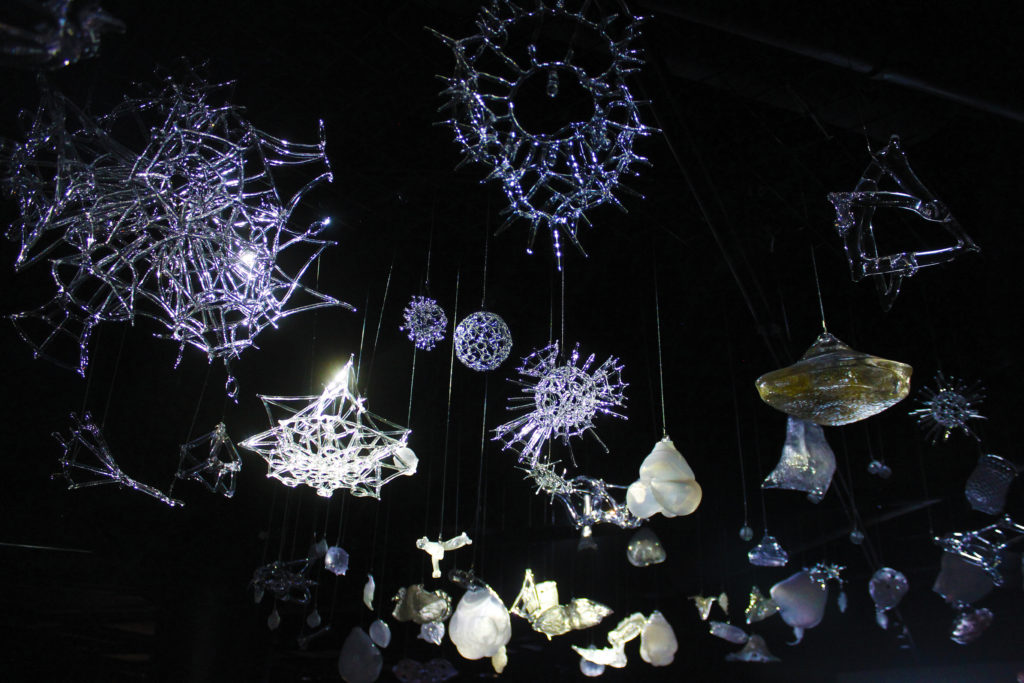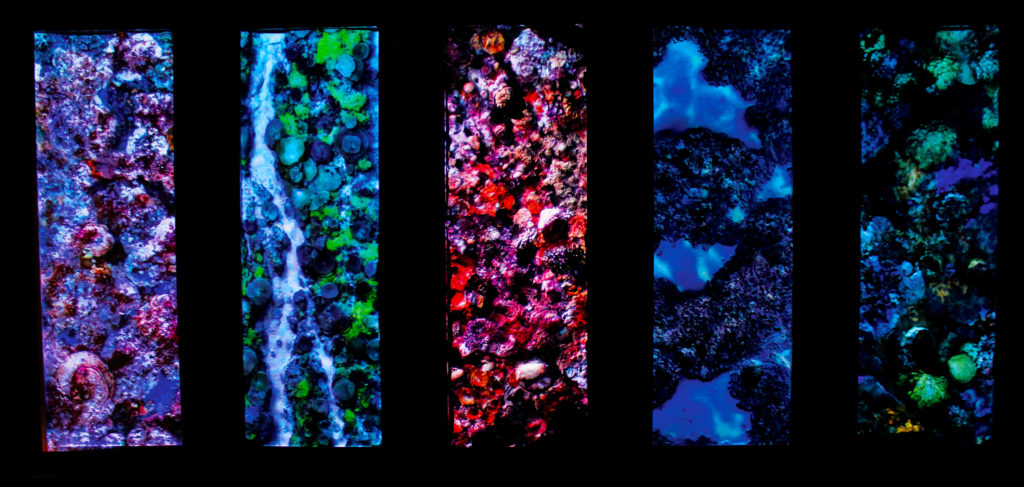At first glance, the shimmering objects dangling from the ceiling of the Pacific Visions art gallery could be mistaken for snowflakes, illuminated brightly against the dark space around them. But the eclectic shapes greeting visitors on their first steps into the Aquarium of the Pacific’s new wing are modeled after plankton, microscopic organisms inhabiting every depth of the sea.
The installation was designed by Convivial Studio, a design studio based in Cologne, Germany. Convivial co-owners Ann-Kristin Abel and Paul Farragut said they drew inspiration from the work of researcher Christian Sardet, who has dedicated his life’s work to documenting the limitless variety of plankton populating the world’s oceans, rivers and lakes.
“Not many people know about all those incredible creatures that live in the ocean, even though they are extremely important for the world ecosystem,” Ferragut explained. Showcasing the beauty hidden below the tides emerged as one of the guiding principles in their work on the Pacific Visions project, Abel and Ferragut noted.
In line with the Aquarium’s focus on sustainability, the plankton models were created from glass, rather than plastic, which has come under fire for contributing to aquatic pollution. “It didn’t make sense to make a sculpture in plastic material or a material that would be unsustainable, [while] talking about plankton,” Ferragut said.

While the verdict is still out on the environmental benefits of glass over plastic, the material is also a direct reference to the organism mimicked in the installation. At the end of their life cycle, plankton descend to the bottom of the sea, becoming one with the sand. Glass, in turn, is made out of sand. “So that was like trying to translate this life cycle with the medium of glass,” Ferragut explained.
In the art gallery, visitors are introduced to the life cycles of the ocean’s creatures, from plankton to coral reefs, and the impact humans have on them. “It’s an interesting combination,” Dr. Jerry Schubel, the Aquarium’s CEO and president, told the Business Journal. “Because the world of plankton, that’s where life begins. Those are the basic building blocks of life in the ocean. And then, coral reefs are among the most endangered ecosystem in the world ocean.”
Coral reefs play a major role in this first room of Pacific Visions. The “Infinity Coral” sculpture installation creates an optical illusion of never-ending coral reefs, modeled after the artist Yayoi Kusama’s popular “Infinity Mirrored Rooms,” which are currently on view at The Broad museum in Los Angeles. In three boxes, “Infinity Coral” showcases corals in different states of health, including some bleached by unsuitably warm water and lab-grown super corals, which are resistant to the effects of global warming on ocean temperatures.
The mirrors creating the illusion of an “infinite” coral reef are arranged in such a way that reflections on one side show a bleached, lifeless reef, while reflections on the other side present a vibrant coral ecosystem. “Side by side, these contrasting views imply two ‘possible futures’ for the world’s oceans,” a proposal submitted by the ArtCenter College of Design explained.
ArtCenter students Alexia Chuck, an undergraduate student of graphic design, and Godiva Reisenbichler, a graduate student of media design practices, conceived the concept as part of a semester-long Pacific Visions Fellowship under the supervision of interaction design instructor Todd Masilko. The fellowship was sponsored by the David and Lucile Packard Foundation, which has long supported the Aquarium’s educational work.
“We loved the fact that [the installation] is very simple – mirrors, lights and colors – but it creates such a surprising visual environment,” Masilko said. Both the “Infinity Coral” installation in the art gallery and the interactive, virtual waterfall in the orientation gallery were also designed with a potential for social media interactions in mind. “Not only are people captivated by it, but they want to be photographed with it – which is just exactly what we want to happen with our installation,” Masilko noted.
To inform the content of their proposal, the ArtCenter group met with Dr. Douglas McCauley, assistant professor of ecology, evolution and marine biology at the University of California, Santa Barbara. “One thing that struck me was when Doug said, ‘You designers are the people who make science matter to people,’” Reisenbichler recounted. “It’s exciting to know that design can be an intermediary for science and communicating it well to the public.’”
To help visitors forge an emotional connection to the ocean is the main function of Pacific Vision’s art gallery, Fahria Qader, the Aquarium’s director of Pacific Visions and architecture, explained. “Art is very important to the Aquarium, because we feel like that’s a stepping stone to getting into or understanding the science part of what we’re teaching,” Qader said. “It’s really about the emotional connection. When you throw people a lot of facts and figures, it’s hard to connect to it.”

To make that connection accessible to as many visitors as possible, the art gallery appeals to more than just the visual sense. “We knew we wanted a multimedia type of installation, rather than traditional art installations,” Qader explained. In addition to the plankton and “Infinity Coral” pieces, the exhibition also features a series of reliefs resembling real-life coral reefs, inviting visitors to touch and explore the rugged surfaces with their hands.
“The Aquarium was very interested in adding a tactile experience, to enable more people to experience the exhibition,” Ferragut noted. The reliefs were modeled after photogrammetric images of coral reefs. Photogrammetry is a technique that allows scientists and researchers to create 3D models from photographs. “We would like to make the entire Pacific Visions wing more accessible and more enjoyable to people who are, particularly, blind and deaf. That was one of the reasons for having a touch component to the art installation,” Qader said.
The exhibition also taps into visitors’ auditory senses, with a soundbed of underwater recordings collected around coral reefs. “A sea reef is very noisy, and that’s something you can hear when you’re snorkeling or diving,” Ferragut said. This is one of the many things the designers learned in their research of marine life, Abel noted. “I never really paid too much attention to the ocean, until I started researching for this project,” she said. “I think that’s the beauty of our work, we always get to learn about new topics and we never do the same work twice. It’s always something new.”
Through their installations, the designers are hoping to inspire the same curiosity among visitors of Pacific Visions and its first room, the art gallery, before they enter the educational part of the new wing. “The first part is more like a meditation on the oceans,” Abel noted. “An immersive experience that’s visually inspiring and hopefully gets people to want to learn more.”
